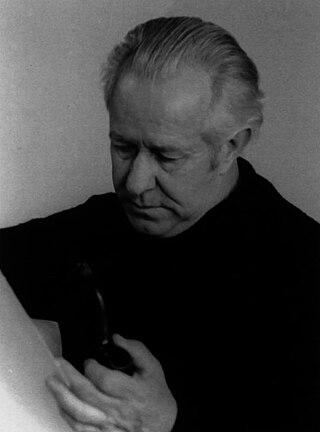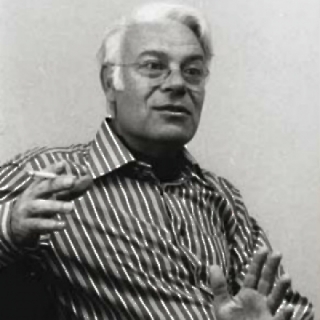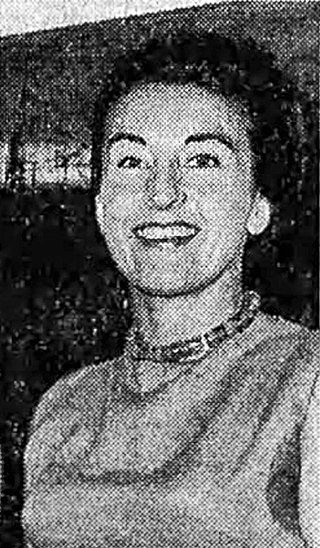Related Research Articles
Heather Shimmen is a contemporary Australian visual artist whose paintings, prints and collages often use sinister historical imagery from 16th to 19th century.

Grahame Edwin King was a master Australian printmaker, who has been called the "patron saint of contemporary Australian printmaking". He was responsible for the revival of print making in Australia in the 1960s. He helped set up the Print Council of Australia, of which he was the first Honorary Secretary and was later President. He taught printmaking at The Royal Melbourne Institute of Technology (RMIT) from 1966 to 1988. In 1991, he was awarded an Order of Australia for his services to education. As well as teaching, King produced his own art work, concentrating on lithographs and monotypes. He was also a skilled photographer and used his photography both in his teaching and in his practice.

Desiderius Orban, was a renowned Hungarian painter, printmaker and teacher, who, after emigrating to Australia in 1939 when in his mid-50s, also made an illustrious career in that country.
Franz Moishe Kempf was an Australian artist who worked in Australia and Europe. He was a lecturer in printmaking at the University of Adelaide.

Vaughan Murray Griffin was an Australian print maker and painter.
Basil Hadley was an English Australian printmaker and painter. His works are represented in National and State public galleries around Australia and in various private collections.
Geoffrey Ricardo is an Australian contemporary visual artist whose work focuses on his sculpture and printmaking practice.

Udo Sellbach (1927–2006) was a German-Australian visual artist and educator whose work focused primarily around his printmaking practice.
Ian Gardiner (1943–2008) was a Melbourne-based artist whose practice ranged from screen printing, linocuts and photographs through to woodblock prints, monoprint, collage and montage. Gardiner also returned to painting late in his career.
Normana Wight is an Australian artist, best known as a painter and printmaker.
Merris Estelle Hillard is an Australian printmaker and photographer, born in Sydney Australia.
Stephen Wickham is an Australian photographer, painter and printmaker.
Sally Robinson is an English-born Australian artist. She has had a long career as a portrait artist and designer, painter and printmaker, teacher and lecturer. Her work is represented in private and public collections around Australia.
Rerrkirrwanga Mununggurr is an Australian artist renowned for her finely detailed paintings on bark. In some publications Rerrkirrwanga is referred to as Rerrki, which appears to be a nickname from her older sister Marrnyula Mununggurr. She is the youngest daughter of the artist Djutjadjutja Munungurr. Her husband, Yalpi Yunupinu, helped train Rerrkirrwanga in the traditions that he painted in addition to what she learned from her father. In the 1990s, Rerrkirrwanga finished many of his works even though they are attributed to her father. She now has authority to paint her own stories and her large-scale works on bark are in Australian and international collections.
Barbie Kjar is an Australian artist and educator, specialising in printmaking and drawing. Her work is included in the permanent collections of the National Gallery of Australia, the National Gallery of Victoria, Tasmanian Museum and Art Gallery, and the Gold Coast City Art Gallery.
Angela Cavalieri is an Australian printmaker, whose work recreates text and narratives in visual form and was included in the Venice Biennale, 2011.
Alick Tipoti, whose traditional name is Zugub, is a Torres Strait Islander artist, linguist, and activist of the Kala Lagaw Ya people, from Badu Island, in the Zenadh Kes. His work includes painting, installations, printmaking, sculpture and mask-making, and is focused on preserving the culture and languages of his people.

Margaret Anne Dredge was an Australian painter and printmaker, active from the mid-1950s until 1997, and teacher of art.

Barbara Nancy Brash was a twentieth-century post-war Australian artist known for her painting and innovative printmaking. In an extensive career she contributed to the Melbourne Modernist art scene, beside other significant women artists including: Mary Macqueen, Dorothy Braund, Anne Marie Graham, Constance Stokes, Anne Montgomery (artist) and Nancy Grant.
Allan Mitelman is an Australian painter, printmaker and art teacher who arrived in Australia in 1953.
References
- ↑ Women 150 (Group) (1985). 150 Victorian women artists. Melbourne?: Women 150. ISBN 978-0-9589286-0-1. OCLC 13214779.
{{cite book}}: CS1 maint: numeric names: authors list (link) - 1 2 3 4 Pamela Bone, "Terra Australia inspires a 'migrant' artist," The Age (Melbourne, Victoria, Australia), 06 Sep 1988, p.18
- ↑ Australian print survey. Adelaide?. 1963. OCLC 51950511.
{{cite book}}: CS1 maint: location missing publisher (link) - 1 2 Maddocks, Hilary (2015). Hertha Kluge-Pott: printmaker. Macmillan Art. ISBN 978-1-921394-79-9. OCLC 905525127.
- ↑ Grishin, Sasha; ‘Profiles in Print – Hertha Kluge-Pott’, Craft Arts International, No. 68, 2006
- ↑ Zimmer, Jenny (7 October 1997). "A geography of awesome art". The Age. p. 31.
- 1 2 Nelson, Robert (29 September 1999). "Visual art: Australian Paper Art Awards, George Adams Gallery, Victorian Arts Centre, until 3 October". The Age. Melbourne. p. 22.
- ↑ Kempf, Franz (1976). Contemporary Australian Printmakers. Melbourne: Lansdowne Editions. OCLC 470182588.
- 1 2 3 4 5 6 McCulloch, Alan; MacCulloch, Susan (1994). Encyclopedia of Australian art. Honolulu: Univ. of Hawai Press. ISBN 978-0-8248-1688-9. OCLC 231633292.
- 1 2 Australian Galleries. "Hertha Kluge-Pott" (PDF). Australian Galleries.
- ↑ Listing, The Age (Melbourne, Victoria, Australia), 14 Jun 1985, p.44
- ↑ "Highlights," The Age (Melbourne, Victoria, Australia), 29 Aug 1994, p.21
- ↑ Advertisement, The Sydney Morning Herald (Sydney, New South Wales, Australia), 03 Nov 2001, p.206
- ↑ "Prints '63. Studio One Printmakers. at Multiple venues (1963 – 1964) · Australian Prints + Printmaking". www.printsandprintmaking.gov.au. Retrieved 22 September 2021.
- ↑ Imprint, Print Council of Australia, Volume 31, No. 2, Winter, 1996
- ↑ Nelson, Robert; ‘Australian Paper Art Awards’, The Age, 29 September 1999
- ↑ Harding, Lesley; & Humphries, Tristan; Australian Paper Art Awards, catalogue essay, the George Adams Gallery, Victorian Arts Centre, Melbourne, 1999
- ↑ Collection. "Hertha Kluge-Pott". National Gallery of Australia. Retrieved 28 September 2021.
- ↑ "Works by Hertha Kluge-Pott | Art Gallery of NSW". www.artgallery.nsw.gov.au. Retrieved 28 September 2021.
- ↑ Online Collection. "Tale for Bennelong". AGSA. Retrieved 28 September 2021.
- ↑ Online Collection. "Hertha Kluge-Pott". National Gallery of Victoria.
- ↑ Kluge-Pott, Hertha. "Tale for Benelong no. 3 1990". Queensland Art Gallery | Gallery of Modern Art. Retrieved 28 September 2021.
- ↑ Kluge-Pott, Hertha. "The tomb of man, 1966". Geelong Gallery Collection. Retrieved 28 September 2021.
- ↑ "Newcastle Art Gallery". newcastle-collections.ncc.nsw.gov.au. Retrieved 28 September 2021.
- ↑ Larkin, Annette; Evolution, Works by Australian Women Artists from Newcastle Regional Art Gallery’s Permanent Collection, Catalogue, February 1995